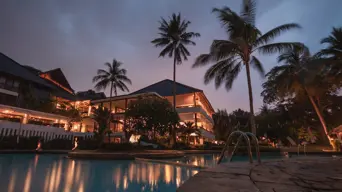What SA’s most expensive resort means for destination-scale tourism
Sponsored
14 October 2025 | 10:35Sponsored by Absa CIB

The announcement of a new Club Med resort, developed by the Collins Residential Consortium, has stirred considerable attention partly because of its scale and partly because of what it represents. With a projected construction cost of nearly R2 billion, it will be the most expensive destination-scale tourism venture in the country’s history – a marker that tells a wider story about a renewed appetite for investment in tourism infrastructure, the potential of projects of this nature to stimulate economic activity across local supply chains, and the sophistication of South Africa’s financial sector in structuring complex transactions in a sector often seen as high-risk.
To grasp the significance of the opportunity now on the table, one must first understand what is meant by destination-scale tourism. The term describes projects or locations that are large and integrated enough to draw visitors in their own right, rather than just absorb or compete for existing flows.
They are the kinds of assets that set down a reason to travel – places where accommodation, leisure, and supportingservices combine into a self-sustaining ecosystem.
In South Africa, this tier of tourism has historically been concentrated in different ways: purpose-built destinations like Sun City; those that leverage natural resources like Kruger National Park, the Drakensberg, and Table Mountain; and entire cities, most prominently Cape Town. Each of these has become a magnet for investment into hotels, recreation, retail, and transport infrastructure clustered around their appeal.
But this concentration carries consequences: capital, skills, and supporting infrastructure have deepened in these well-established areas, while other regions have been left comparatively underdeveloped. For South Africa to broaden its tourism economy, new anchors of this scale must emerge – projects capable of redistributing demand and creating alternative entry points for both domestic and international visitors.
When they do, the effect on local economies is multiplied.
Inthe case of Club Med, initial estimates suggest more than 800 direct jobs, 1,500 indirect jobs, and 1,200 construction workers during the build. Yet what matters more than the headcount is the durability of the linkages that form around the project.
Large resorts draw in suppliers of food, cleaning, and transport, expand demand for training institutions, and stimulate entire micro-industries from laundry services to entertainment. Once operational, the spending power of visitors circulates through farms, factories, and service providers that are far removed from the hotel lobby. Infrastructure is pulled into the mix as well: roads are upgraded, utilities strengthened, and digital connectivity improved, each of which benefits surrounding communities as much as tourists.
It is in these connections that destination-scale tourism shifts from being a leisure investment to becoming a development asset.
The project becomes embedded in the regional economy, creating patterns of demand and employment that outlast the initial construction boom and anchor long-term growth
The question, then, is how to create a better pipeline of investments of this size.
Destination-scale projects are almost always greenfield ventures – conceived on undeveloped land, without existing operations or cash flows to underwrite. That makes them inherently risky: investors cannot lean on a proven revenue stream or established collateral, and financing must be structured around what the project could generate rather than what it already delivers. The economics typically split into two layers. Equity provides the foundation, taking on the highest risk because it is exposed first if revenues fall short. Debt sits above that, supplied by commercial banks or bond markets, and is only viable if lenders are confident that repayment will be secured.
In this case, equity was raised by the Collins Residential Consortium together with partners including African Bank and the Industrial Development orporation of South Africa. With that foundation in place, the debt could then be structured, with Absa as lead arranger committing just over half of it.
To scale this model, we will need mechanisms that extend beyond one-off partnerships.
Conventional hotel lending in South Africa is designed for stabilised city assets with short tenors and predictable income. Applied to a R2-billion resort, the result is debt capacity far below the capital required, leaving an equity gap that private sponsors cannot always close.
Development finance institutions are essential in bridging this gap. They fund feasibility and design work that reduces unknowns; they provide junior or quasi-equity that absorbs the earliest risks; they extend repayment periods with grace years that reflect the slow build-up of tourism revenues; and they enforce policy and environmental standards that give comfort to later lenders.
Their involvementbecomes a signal in its own right: once a DFI has cleared environmental baselines, land rights, permits, and community agreements, the project’s risk is significantly diminished. At that point, commercial banks can model cash flows credibly and structure debt with confidence.
The point is not to add layers of complexity, but to build a repeatable financing model.
And for that model to attract capital at scale, it must be matched by an operating environment that reduces friction and builds confidence. Investors look at more than cash flows: they weigh the reliability of core infrastructure, the predictability of regulation, and the credibility of sustainability standards. Roads, energy, and water must support the scale of development being proposed; permits and approvals must be navigable within reasonable timelines; and environmental and community commitments must be enforced with consistency.
The hope is that Club Med acts as a first mover.
When a global operator of this scale enters a new market and succeeds, it can reset perceptions of risk and demonstrate that destination-scale tourism in South Africa is viable. A single project does not transform the sector on its own, but it can become a catalyst – creating the momentum, the operating environment, and the infrastructure that encourage other major players to follow. If that happens, the impact extends well beyond one resort: it positions South Africa to broaden its tourism economy through a new generation of destination-scale anchors.
By Vumiso Nyamazana – Regional Head: Corporate Property Finance, Absa CIB
Annah Watkinson – Head of Global Finance: Coastal Regions, Absa CIB
Get the whole picture 💡
Take a look at the topic timeline for all related articles.
Trending News
More in The Money Show

1 December 2025 18:55
Meet Vafa Naraghi: the multilingual engineer-turned-comedian who’s taking Mzansi by storm

1 December 2025 18:17
Discovery Life marks 25 Years with shift toward 'Living Benefits' as industry faces R50 trillion protection gap

1 December 2025 17:29
Bumper year for new vehicle sales as 2025 surges ahead











